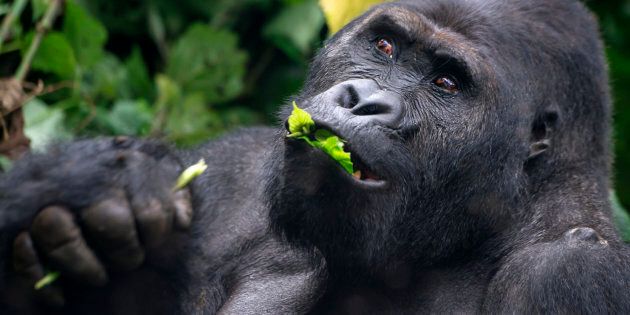
HONOLULU ― If humans continue down our current path, we may soon find ourselves living in a world with no other great apes.
On Sunday, the Eastern gorilla, the largest living primate species, was listed as critically endangered on the International Union for Conservation of Nature’s updated Red List of Endangered Species.
The reclassification means that four out of the six non-human great ape species ― the Eastern gorilla, Western gorilla, Bornean orangutan and Sumatran orangutan ― are now listed by IUCN as critically endangered, the closest category to extinction. The other two, the chimpanzee and bonobo, are listed as endangered.
“Today is kind of a sad day because the IUCN Red List shows we are wiping out some of our closest relatives,” Inger Andersen, IUCN’s director general, said Sunday during a press conference a the organization’s World Conservation Congress in Honolulu.
Over the last 20 years, the Eastern gorilla has seen a “devastating population decline” of more than 70 percent, mainly as the result of illegal hunting, according to the world conservation union. One subspecies, the Grauer’s gorilla, has dropped from 16,900 to 3,800 individuals since 1994, while the other, the mountain gorilla, has a population of around 880.
“We are the only one species of great ape that is not threatened with extinction,” said Carlo Rondinini, a research scientist at Sapienza University of Rome and member of the IUCN red list committee. “This is something we should really reflect about.”

The Eastern gorilla’s new designation comes on the heels of an April survey by the Wildlife Conservation Society that showed an estimated 77 to 93 percent decline in Grauer’s gorilla across its range.
In a statement Sunday, the survey’s lead author, Andrew Plumptre, a senior conservationist in the WCS Uganda program, applauded IUCN for accepting the new listing recommendation.
“Critical Endangered status will raise the profile of this gorilla subspecies and bring attention to its plight,” Plumptre said. “It has tended to be the neglected ape in Africa, despite being the largest ape in the world.”
IUCN’s updated list highlights the extinction crisis taking place across the planet. In addition to Eastern gorillas, the plains zebra was uplisted from “least concern” to “near threatened” following a 24 percent population loss over the past 14 years. Three species of African antelope also moved to near threatened.
In Hawaii, a biodiversity hotspot, 38 of 415 assessed endemic plants are listed as extinct, with an additional four existing only in cultivation and listed as extinct in the wild, according to IUCN.
“This update also highlights, for example, the devastating impact of invasive species,” Andersen said Sunday. About 87 percent of Hawaii’s endemic plants are threatened with extinction.
But IUCN’s updated list also offered glimmers of hope. Thanks to conservation efforts by the Chinese government, for example, the giant panda is on the mend. The species’ status was updated Sunday from endangered to vulnerable.
Additionally, the Tibetan antelope moved from endangered to near threatened.
Andersen said it is vital for the list to drive conservation action ― otherwise species will be lost forever.
“And once they are gone, they really are gone,” she said.
IUCN’s World Conservation Congress, which is being held in the U.S. for the first time in the organization’s 68-year history, is the world’s largest environment and nature conservation event, often referred to as the Olympics of conservation. The year’s event has drawn more than 9,000 delegates from 190 nations.
During a panel discussion at the conference Saturday, famed British anthropologist Jane Goodall said that when it comes to protecting the planet, apathy is unacceptable. Every single person has a role to play and a choice to make, she said.
“We have been stealing the planet from our children for years,” Goodall said. “We’re still stealing it today.”
